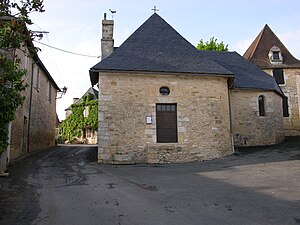Les Farges
|
Les Farges Las Farjas |
||
|---|---|---|
|
|
||
| region | Nouvelle-Aquitaine | |
| Department | Dordogne | |
| Arrondissement | Sarlat-la-Canéda | |
| Canton | Vallée de l'Homme | |
| Community association | Vallée de l'Homme | |
| Coordinates | 45 ° 7 ' N , 1 ° 11' E | |
| height | 71-267 m | |
| surface | 8.14 km 2 | |
| Residents | 319 (January 1, 2017) | |
| Population density | 39 inhabitants / km 2 | |
| Post Code | 24290 | |
| INSEE code | 24175 | |
 Les Farges - town center with a chapel |
||
Les Farges ( Occitan : Las Farjas ) is a place and a southwestern French community ( commune ) with 319 inhabitants (at January 1, 2017) in the old cultural landscape of the Périgord in the department of Dordogne in the region Nouvelle-Aquitaine .
location
The place Les Farges is located in the Périgord Noir on a hill in the northwest of the valley of the Vézère at an altitude of about 240 m above sea level. d. M. about 32 kilometers (driving distance) north of Sarlat-la-Canéda ; the canton's capital, Montignac , is only about seven kilometers south.
Population development
| year | 1968 | 1975 | 1982 | 1990 | 1999 | 2006 | 2012 |
| Residents | 151 | 159 | 180 | 228 | 262 | 314 | 319 |
In the 19th century the population of the community was always between about 200 and 350. The phylloxera crisis in viticulture and the loss of jobs as a result of the mechanization of agriculture led to a continuous decline in the population to the lows in the 1930s.
economy
The agriculture, which has been practiced for centuries for the purpose of self-sufficiency, is still of great economic importance for the community today. The viticulture, which was formerly also operated here, was completely given up after the phylloxera crisis; Tobacco and corn are also on the decline - instead, forests, fields and pastures, but also walnut , chestnut and fruit trees dominate the region. Also, foie gras and truffles are among the best regional cuisine. Some vacant houses are rented out as holiday apartments ( gîtes ).
history
The place name Les Farges is not mentioned until the 18th century. The hamlet of Cheylard , which belongs to the municipality but has long been abandoned, has - as the church ruins prove - a history that goes back at least to the 11th century.
Attractions
- Some streets in the town center ( bourg ) are lined with quarry stone houses .
- The small chapel dates from the 18th century.
- The ruins of the church in the abandoned hamlet of Cheylard are worth a stroll.
